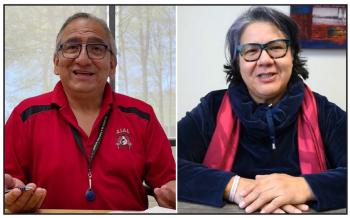Image Caption
Summary
Local Journalism Initiative Reporter
Windspeaker.com
Delegates at the Chiefs of Ontario’s virtual Special Chiefs Assembly Feb. 3 voiced concerns over testing and the need to inoculate a wider range of people as the COVID-19 vaccination program rolls out.
While Elders rightfully remain a priority, chiefs said attention needed to be paid to workers coming on reserve to do vital work, personal health workers moving from home-to-home caring for Elders and community members, released inmates returning to their communities, and women living in the protection of shelters.
Concerns were directed to Ontario Regional Chief RoseAnne Archibald, who sits as a member of the Minister’s COVID-19 Vaccine Distribution Task Force for the province.
Elders living in long-term care facilities, both on and off-reserve, and health care workers have been set as priorities by the task force for receiving either the Pfizer-BioNTech or Moderna vaccines.
“As we moved through the process at the task force we ensured that First Nations are the third priority behind long-term care homes and health care workers,” said Archibald.
“There are about 1.2 million people ahead of us on the list,” she said.
However, in the “next week or two” Elders in congregate settings—homes that don’t qualify as long term care—will be receiving the vaccine.
As well, she pointed out, close to a dozen remote northern First Nation communities have begun to be vaccinated through the Operation Remote Immunity initiative. The program will see people 18 years and over in the 31 Nishnawbe Aski Nation (NAN) fly-in communities and Moosonee receive the Moderna vaccine over the next three months.
Operation Remote Immunity is a collaboration between NAN, Ornge (air ambulance), the Ontario’s ministries of Health, Indigenous Affairs, Solicitor General, Natural Resources and Forestry, and federal government partners.
Archibald said all vaccine teams that are flying into the remote communities have received their two doses of a COVID-19 vaccine and have also received cultural training.
However, not everybody coming into the communities has been vaccinated.
Rocky Bay First Nation Chief Melvin Hardy pointed out that while work on the water and wastewater treatment plant on his Nation is “averting a disaster” when it comes to safe drinking water, it’s opening the door to the spread of coronavirus as workers are not vaccinated.
He also expressed concern about the testing of inmates that are released.
“The inmates being released are coming into our communities and they’re creating crises because they’re spreading (COVID-19),” said Hardy.
For Batchewana First Nation Chief Dean Sayers concerns centred on personal health care workers who moved from home-to-home caring for Elders and community members, as well as women in shelters.
“There’s some transmission ability that happens there. There’s a lot of times in and out of (the women’s shelter) into the community,” said Sayers.
“We’ve got to start to think of what’s beyond vaccinating all of our Elders across Ontario,” said Archibald, who assured chiefs she would raise their issues at the next sub-group meeting for the vaccine committee.
Archibald was appointed to the vaccine task force on Dec. 4 after she approached Ontario Premier Doug Ford to be kept in the know with how the vaccine would roll out. Instead, he appointed her to the committee.
“I was there in order to provide advice and recommendations particularly from a First Nations perspective,” she said.
Two subgroups were appointed by Indigenous Affairs Minister Greg Rickford, one focusing on First Nations on reserve and the other on the urban Indigenous population.
Indigenous Affairs has developed a matrix to prioritize First Nations, said Archibald.
“That matrix looks at all different factors of what are the highest priority communities and they’ve broken them down now into four tiers,” she said.
A concept of operations is now in the works as to how the vaccine will be rolled out in the four tiers. There may be some overlap or some concurrent roll-out, said Archibald.
“There’s a lot of figuring out to do,” she said.
“This pandemic has been a revolving challenge for all of us, especially now that we are in a second wave. First Nations despite this continue to do tremendous work in protecting their communities. Our collective goal is, of course, to have zero new and zero active cases in First Nation communities,” said Archibald.
“With respect to the movement of the pandemic within First Nations, we have had successes in general as our communities have experienced lower numbers than the rest of the province. And when it has arrived, leadership and their staff have done a great job in stomping it out and returning back to zero active cases,” she said.
According to Indigenous Services Canada numbers as of Feb. 2, Ontario First Nations have 539 positive cases, ranking them fifth and far below provinces like Alberta and Manitoba, which with 5,215 and 4,595 positive cases, rank first and second, respectively.
In total, there are 17,201 confirmed cases of COVID-19 on reserves across Canada.
The Special Chiefs Assembly continues on Thursday.
Local Journalism Initiative Reporters are supported by a financial contribution made by the Government of Canada.

